Introduction
In times of emergency situation, the ability to perform Cardiopulmonary Resuscitation (MOUTH-TO-MOUTH RESUSCITATION) can be the distinction in between life and fatality. In Australia, recognizing the CPR certification requirements is important for any individual wanting to end up being a qualified rescuer. This extensive overview will certainly explore what you need to understand about mouth-to-mouth resuscitation accreditation in Australia, consisting of training alternatives, validity of certificates, age-specific standards, and more.
CPR Certification Demands in Australia: What You Need to Know
What is CPR?
Cardiopulmonary Resuscitation (MOUTH-TO-MOUTH RESUSCITATION) is an emergency procedure performed when a person's heart quits beating or they stop breathing. It incorporates breast compressions with rescue breaths to keep blood circulation and oxygenation until expert clinical help arrives.
Why is mouth-to-mouth resuscitation Important?
The essential value of CPR can not be overstated-- it conserves lives. According to statistics from the Australian Resuscitation Council, instant CPR can double or triple a victim's possibility of survival affordable first aid courses Wagga Wagga after cardiac arrest.
Understanding mouth-to-mouth resuscitation Certification
To come to be accredited in mouth-to-mouth resuscitation, people have to go through training with recognized organizations. Accreditations generally consist of hands-on abilities technique and academic knowledge about heart emergencies.
Types of CPR Educating Available
Basic Life Support (BLS) vs. Advanced Life Assistance (ALS)
- Basic Life Support (BLS) concentrates on fundamental techniques consisting of upper body compressions and rescue breaths. Advanced Life Support (ALS) covers a lot more complex treatments such as sophisticated air passage management and drug administration.
Online vs. In-Person Training
- Online mouth-to-mouth resuscitation certification deals adaptability however may do not have hands-on experience. In-person courses supply sensible abilities method important for efficient response in emergencies.
CPR Certification Process
Choosing an Educating Provider
When seeking training, ensure that your selected service provider is certified by trustworthy organizations like the Australian Resuscitation Council or St John Ambulance.
Course Duration and Content
Most basic programs last regarding 4 hours and cover:
- Adult CPR techniques Use of Automated External Defibrillators (AED) Recognition of cardiac arrest signs
CPR Certificate Validity
How Long Does a Mouth-to-mouth Resuscitation Certificate Last?
Typically, a CPR certificate remains valid for 3 years before requiring renewal. It is crucial to remain upgraded with the current protocols and guidelines.
Renewing Your Certification
Renewal commonly involves taking a refresher course that reviews important skills and updates guests on any type of adjustments in guidelines.
Age-Specific CPR Guidelines Australia
Adult vs. Kid vs. Baby CPR Techniques
Different age groups require tailored approaches:
- For grownups, concentrate on compression depth and rate. For kids, adjust compression depth based upon size. Infant CPR technique involves mild compressions and cautious ventilation.
Infographic: Age-Specific Techniques
|Age Group|Compression Depth|Ratio|| -----------|-------------------|-------|| Adults|5-6 cm|30:2|| Children|4-5 centimeters|30:2|| Babies|1.5 cm|30:2|
CPR Equipment in Australia
Essential Gear for Reliable Response
Having access to proper CPR equipment help successful resuscitation initiatives:
AEDs Pocket masks GlovesUsing AED with mouth-to-mouth resuscitation in Australia
An Automated External Defibrillator can considerably boost survival prices when made use of together with CPR-- recognizing just how to utilize an AED effectively is important for each rescuer.

Common Misconceptions About CPR
The Myth of "Mouth-to-mouth Resuscitation Always Restarts Heart"
Many think that doing mouth-to-mouth resuscitation will certainly constantly reboot a heart; nevertheless, this is misleading-- mouth-to-mouth resuscitation maintains blood circulation until expert help gets here however certified first aid courses Wagga Wagga does not guarantee revival.
Debunking Various other Misconceptions
Other myths consist of misunderstanding compression deepness or the effectiveness of rescue breaths versus hands-only approaches; education plays a crucial role in resolving these falsehoods.
Special Circumstances in Carrying out CPR
CPR for Sinking Victims
Drowning victims often call for immediate rescue breaths due to their special conditions; recognizing this context enhances outcomes significantly.

Sports-Related Cardiac Arrest Procedures
Recognizing indicators certain to professional athletes helps -responders act quickly-- education concerning sports-related cardiac cases is imperative for instructors and fitness instructors alike.
Workplace Emergency Plans
Establishing Preparedness at Workplaces
Every office ought to have a comprehensive emergency situation strategy that includes arrangement for first aid training like cpr and emergency treatment combo training courses for employees.
Training Employees Effectively
Regular training sessions make sure personnel are prepared-- not only does this secure staff members but also improves total work environment safety and security culture.
Frequently Asked Questions (FAQs)
Q1: Exactly how do I locate local CPR classes?

Q2: Can I get my accreditation online?
A2: Yes! Lots of recognized organizations offer online mouth-to-mouth resuscitation certification, but guarantee it includes hands-on practice components as well.
Q3: Is there a difference between adult and child certifications?
A3: Yes! Programs especially customized for infants and youngsters concentrate on age-specific techniques which differ from those instructed for adults.
Q4: How usually need to I restore my certification?
A4: Normally every 3 years; however, staying upgraded each year with refreshers is highly advised provided developing guidelines.
Q5: Exist any type of particular legislations concerning required training?
A5: While regulations might vary by state or region, numerous work environments are required by regulation to have educated very first -responders offered on-site during working hours.
Q6: What stats sustain the efficiency of CPR?
A6: Researches indicate that instant bystander-administered mouth-to-mouth resuscitation can raise survival prices from heart attack significantly-- often increasing opportunities of client recuperation compared to no treatment at all.
Conclusion
Understanding the complexities of the CPR accreditation requirements in Australia equips people across numerous markets-- from health care specialists to everyday residents-- to act decisively during emergencies. With appropriate training, understanding of age-specific standards, expertise about tools such as AEDs, and knowledge with usual myths bordering resuscitation efforts, one can really make a difference when it matters most. Whether you're considering signing up in neighborhood courses or checking out on the internet alternatives like online mouth-to-mouth resuscitation certification, remember that each step taken towards becoming qualified contributes towards conserving lives-- a noble search indeed!